A New Way to Fight Overdose

When Dave Lozier campaigned to be the district attorney of Beaver County, one topic dominated conversation at every meet-and-greet and campaign stop.
“I was up in rural Darlington Township and down in Monaca and the [more populated] river towns and everyone kept asking, ‘What can we do about these overdoses?’ ” recalled Lozier, a former private-practice attorney elected in 2015. “There was no one demographic or region affected; everyone knew someone who had OD’d.”
As with many suburban areas, overdoses were once rare in Beaver County but have snowballed in a few years. In 2012, 20 OD deaths were reported by the county coroner. By 2016, that number swelled to 102. Over the same time period, OD fatalities rose by more than 50 percent nationally, reaching 63,632 in 2016 and propelled by increased opioid use in places with demographics like those of Beaver County: suburban or rural, middle-class and people first hooked through prescription painkillers. Small-town police, hospitals, prosecutors, correctional officers and human services agencies faced a pervasive, multifaceted problem new to them.
The numbers of deaths, Lozier knew, reflected a small percentage of overdoses and addictions.
After he took office, Lozier turned to a new resource, the PA Heroin Overdose Prevention Technical Assistance Center of the University of Pittsburgh’s School of Pharmacy. A program of the school’s research unit, the TAC provides public-health experts to help local officials navigate their own battlefront in the opioid crisis. Its mission is to solve the mounting addition epidemic with data analysis—and with it the possibility of better strategy.
After Lozier and Beaver County Coroner David J. Gabauer gave their facts and figures for analysis by the TAC, they saw some patterns. Most 911 calls about overdoses happened Thursday through Saturday and during the evening shift for ambulance companies, 4 to 12 midnight. The county increased staffing at the time. Lozier also has emergency medical technicians make incident reports of drug activity to refine and update their data, and he’s prioritized getting all 34 police departments in the county to carry and use the anti-overdose medication naloxone, as the data showed ODs were spread across the county.
The data is also useful in Luzier’s pushes for reform. The DA started a pilot program for drug offenders in Beaver Falls, diverting them to rehabilitation services instead of jail. It’s kept 60 to 70 of enrollees clean (according to urinalysis tests), he said, and Luzier hopes to extend it across Beaver County. New approaches are not always easy sells among the plethora of offices and departments that make up a county’s web of agencies and responders, but Lozier says having rich data available helps him bend ears. “We can show people the problem is in their community and exactly how bad it is.”
The situation is bad all over Western Pennsylvania. The mosaic painted by the data collected and made available on the TAC’s website, www.overdosefreepa.pitt.edu, is a grim picture.
Allegheny County had 717 overdose deaths in 2017 and 650 in 2016. Deaths have more than doubled since 2014—when 306 people died and the words “crisis” and “epidemic” were already employed by headline writers.
Neighboring counties show the same trend on smaller scales: a handful of overdose fatalities in the early ’10s and then a sharp slope upwards. Westmoreland County reached 192 deaths in 2017 (up from 78 in 2012). Butler County rocketed to 92 (from 5 in 2012). Armstrong County climbed to 38 (from 11 in 2012). And Indiana County also budged to 38 (from 21 in 2012). Washington County officials have leaned on the TAC for help coordinating services, but Coroner S. Timothy Warco doesn’t submit overdose data for their publication because of concerns about privacy laws, he said.
The TAC doesn’t just collect the data but applies it, with an approach refined when the scourge of opioid death was emerging.
The TAC grew out of Dr. Janice Pringle’s collaboration with Allegheny County medical examiners in the mid ’00s. “The purpose was to set up an entity with a name and mission and private funding that could respond to this problem,” said Pringle, founder and director of the School of Pharmacy’s Program Evaluation and Research Unit. Allegheny County has since moved its resources mostly in-house. But the partnership created a model: rich data and coordination between first responders, like EMTs and police, and addiction treatment services that offer a softer, more effective approach than criminal prosecution. In 2013, the school received a grant from the state Commission on Crime and Delinquency to begin the TAC and apply it to any Pennsylvania county interested.
The project occupies an office space on Baum Boulevard in Shadyside and employs several young researchers with public health backgrounds. Some are new to the fields of drugs and addiction.
Dr. Lynn Mirigian, Ph.D., the program director, previously researched bone and teeth diseases, studying cell stress and protein synthesis. She once spent several “hours every week with mice and no human contact,” she recalled. She took this job “to make an impact and improve health and safety.”
Project coordinator Megan Neuf says that addiction is not that different from other public health problems in its complexity. “They are all complex problems. With heart disease, you can’t say it isn’t impacted by community resources and demographics and other impacts on health.”
The TAC receives data from local partners through a digital “back end” and standardizes and analyzes it. They keep the information updated to respond to an ever-evolving problem. Some county medical examiners send in OD reports as death certificates are written.
Neuf said that only 10 percent of their time is spent on data crunching; much of the job is meeting with county officials to formulate a plan tailored to their resources and network of agencies and responders. “Primarily what we do is provide concierge-style service to counties,” said Neuf. Forty-seven of Pennsylvania’s 67 counties participate in some way.
The county’s data supply allows the TAC to show breakdowns of fatalities by age, gender, race and drug(s) present. The last gives a key as to why overdoses have ramped up in the last two years: a high-octane drug has infiltrated the opioid black market.
Fentanyl is an artificial opioid that the National Institute on Drug Abuse warns is 50 to 100 times more potent than morphine. First synthesized in 1960, it has been used as pain reliever in hospitals and war zones and now is a favorite product of the manufacturers whose products reach Pennsylvania streets, according to Patrick J. Trainor, public information officer for the Drug Enforcement Agency’s Philadelphia Division.
“It’s a lot cheaper for them to make than heroin and it’s not subject to a growing season” like the opium poppy from which heroin is derived, said Trainor. Dealers can dole out smaller amounts of fentanyl, or a chemical analog of it, and cut it with filler like starch or talcum powder for higher profits. Also, the stuff is often packaged and sold as heroin, said Trainor, meaning the user might not know what’s in their syringe.
Fentanyl has quickly become the most deadly drug in Western Pennsylvania, according to TAC data. In 2017, it was the one most present in overdose deaths in Allegheny County, showing up in nearly 75 percent of them, a jump from 26 percent in 2014, the first year it made the top 10. In 2017, it was also the most common drug present at overdoses in all the surrounding counties that provided data.
The drug may have stagnated progress in lowering overdose trends. “Fentanyl came in 2015 and hit a large number of individuals,” said Laken Ethun, lead research specialist for the TAC. “It correlates nicely to that increase.”
The problem of fentanyl also shows the value of a data-driven approach. One particularly strong batch can arrive in a locale and officials have to react quickly, monitoring their emergency rooms and 911 calls.
In October of 2017, a supply of carfentanil, a variation of fentanyl 100 times more powerful than the usual, came to Indiana County. It killed at least five people, said Coroner Jerry Overman Jr.
“The first three [deaths] came within three days,” said Overman. “That heightened everyone’s awareness.”
The county’s response had already been beefed up through its collaboration with the TAC, said Carrie Bence, deputy director of the Armstrong Clarion Indiana Drug and Alcohol Commission. “We had saturated our counties with [naloxone] and we noticed some trends regarding ambulance shifts,” she said. Overman increased stock of naloxone and warned first responders that the antidote may not work as usual against such an overpowering drug.
Overman said county officials also used some small-town scuttlebutt. Social service workers warned people who were thought to be drug buddies of the recently deceased.
Indiana County actually saw a dip in its overdose rates from 2016 to 2017: from 53 to 38, which Bence attributes to better coordination and the implementation of a “warm hands” program that connects users hesitant to go to the ER after a 911 call with social services.
Overman has a grimmer theory: Indiana County reached its peak death toll. So many hard drug users have already died from overdose that there are fewer around to inject the fatal stuff that is now circulating. “I think a lot of the customer base has already died out.”
The office of the TAC is a web of cubicles connected to a conference room and a reception area. It looks like it could be a real estate firm or software developer, not an agency that considers life-and-death scenarios and the anguish of addicts every day.
Program director Mirigian said it’s important to remember that and not get lost in a spreadsheet. “If we are compiling numbers, it helps [local officials] to devise strategies,” she said. “It’s not the numbers that are important; it’s the lives.”
When asked the program’s overall goal, she keeps it straightforward and almost grandiosely idealistic: “Eliminating overdoses is my ideal vision,” Mirigian said. “That’s my goal, for there to be zero overdoses in Pennsylvania.”




